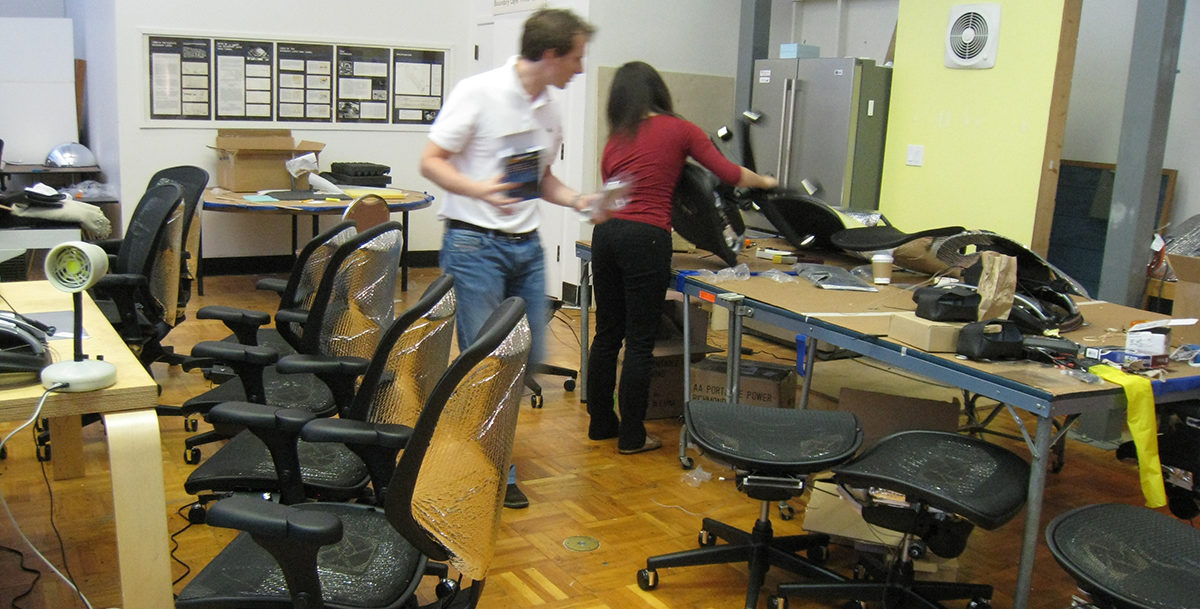Providing local individual thermal comfort for occupant satisfaction and reduced energy consumption.
Status: Current
Funding Sources: CBE Industry Consortium California Energy Commission PIER Buildings Program California Institute for Energy and Environment (CIEE)
Project Objective
The purpose of this research is to optimize the efficiency and demonstrate the practical applicability of Personal Comfort Systems (PCS) for improved thermal comfort and energy savings in office environments.This research seeks to remove barriers to industry adoption of low-energy thermal ergonomics through product design, laboratory testing and field research.
Significance to Industry
Major advances in office design and furniture have drastically improved workplace ergonomics. However, less attention has been directed at the thermal aspects of the workspace. Surveys show that most workers find their thermal environment uncomfortable, even though commercial buildings expend enormous amounts of energy on heating, cooling and ventilation.
Providing occupants with low-power devices to control their local thermal environment allows them to remain comfortable over a wider range of ambient temperatures. Building simulations show that allowing the indoor ambient temperature to vary by even a few degrees can result in large energy savings because the building is conditioned less intensely and less often, and can more often use outside air for conditioning (economizer mode). While savings vary by climate, widening the dead-band by one degree Celsius can reduce building-energy consumption
by 5-15%.
Research Approach
Previous findings show that cooling of the head and “breathing zone,” and providing warmth to the occupant’s feet are two of the most effective ways to provide individualized thermal comfort. This background informs the design, construction and laboratory testing of prototype PCS to optimize performance. Iterative testing guides the detailed industrial design, fabrication and manufacture of approximately one hundred units, each of which incorporates research sensors and instrumentation. With the help of our industry partners, these units are field-tested in actual office spaces for demonstration and evaluation of performance.
Laboratory testing includes the use of our thermal manikin for calibrated measurements of cooling fan efficiency. The field-study portion of the project combines user surveys with measurements of occupancy, occupant use, energy consumption and ambient conditions collected by the PCS units and forwarded to our research database.
The research team received additional funding in 2013 from the California Energy Commission to expand this research scope over three years. The work will be conducted in collaboration with UCB’s Electrical Engineering and Computer Science Department, the California Institute for Energy Efficiency, and Taylor Engineering.
CBE researchers have developed a user-controlled chair which allows users to control heating and cooling that is provided directly through the surfaces of an office chair. This provides comfort under a wide range of room temperatures (previous tests that CBE conducted with another “active” chair kept people comfortable from 61°F to 84°F). CBE’s chair uses low-energy fans, a reflective exterior, small heating elements, and an occupancy sensor to save energy when not in use. The chair is battery powered, and can last several days between charges. A simple control in the armrest sets the heating and cooling intensity.
Publications and Reports
Lehrer, D., E. Arens, H. Zhang, and D. Fannon. 2020. Prototyping solutions to improve comfort and enable HVAC energy savings. Proceedings, ACEEE 2020 Summer Study on Energy Efficiency in Buildings. August.
Kim, J., F. Bauman, P. Raftery, E. Arens, H. Zhang, G. Fierro, M. Anderson, and D. Culler. 2019. Occupant comfort and behavior: High-resolution data from a 6-month field study of personal comfort systems with 37 real office workers. Building and Environment.
Andersen, M., G. Fierro, S. Kumar, J. Kim, E. Arens, H. Zhang, P. Raftery, and D. Culler. 2016. Well-connected microzones for increased building efficiency and occupant comfort. Proceedings of ACEEE Summer Study on Energy Efficiency in Buildings. Pacific Grove, CA. August 21-26.
Zhang, H., E. Arens, and Y. Zhai. 2015. A review of the corrective power of personal comfort systems in non-neutral ambient environments.. Building and Environment, 91, 15-41. http://dx.doi.org/10.1016/j.buildenv.2015.03.013
Zhang, H., E. Arens, M. Taub, D. Dickerhoff, F. Bauman, M. Fountain, W. Pasut, D. Fannon, Y.C. Zhai, and M. Pigman. 2015. Using footwarmers in offices for thermal comfort and energy savings. Energy and Buildings. July. http://dx.doi.org/10.1016/j.enbuild.2015.06.086
Pasut, W., H. Zhang, E. Arens, and Y. Zhai. 2015. Energy-efficient comfort with a heated/cooled chair: results from human subject tests. Building and Environment, Vol. 84, 10-21. “http://dx.doi.org/10.1016/j.buildenv.2014.10.026
Zhang, H., E. Arens, D. Kim, E. Buchberger, F. Bauman, and C. Huizenga. Comfort, perceived air quality, and work performance in a low-power task-ambient conditioning system. Building and Environment. 2009.
Hoyt, T., E. Arens, and H. Zhang. 2014. Extending air temperature setpoints: Simulated energy savings and design considerations for new and retrofit buildings. Building and Environment. http://dx.doi.org/10.1016/j.buildenv.2014.09.010
Bauman, F., H. Zhang, E. Arens, P. Raftery, C. Karmann, J. Feng, Y. Zhai, D. Dickerhoff, S. Schiavon, and X. Zhou. 2015. Advanced Integrated Systems Technology Development: Personal Comfort Systems and Radiant Slab Systems. Final report to CEC. June.
Zhang, H., E. Arens, D. Kim, E. Buchberger, F. Bauman, and C. Huizenga, 2010. Comfort, perceived air quality, and work performance in a low-power task-ambient conditioning system. Building and Environment, 45, 29-39.
Hoyt, T., H. L. Kwang, H. Zhang, E. Arens, and T. Webster, 2009. Energy savings from extended air temperature setpoints and reductions in room air mixing. International Conference on Environmental Ergonomics, Boston, July.
Bauman, F., A. Baughman, G. Carter, and E. Arens, 1998. A field study of PEM (Personal Environmental Module) performance in Bank of America’s San Francisco office buildings. CEDR-01-07.

